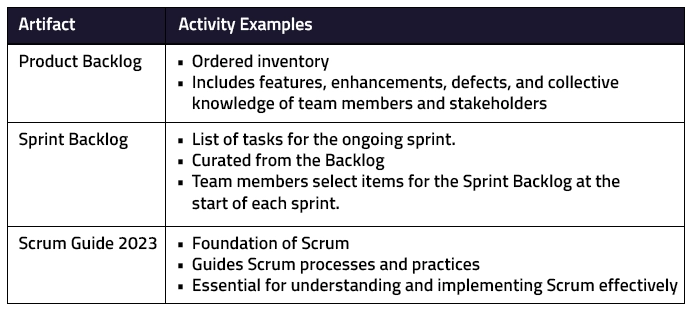Scrum strikes out as more than simply a traditional project management system. It is an innovative leadership framework that allows teams to self-organize and trust people with their duties. Rather than decreasing managers’ roles, Scrum encourages them to adapt and interpret their tasks in a new light. To realize Scrum’s full potential, it is critical to understand its inner workings and properly adopt it inside the company. While the Scrum Guide is the definitive reference, it might be excessively technical for managers looking for a quick overview. This blog discusses an executive overview of the Scrum Guide.
Scrum’s Origins and Core Values
Scrum started in the 1980s, when the software development scene constantly developed, offering new technologies with diverse applications. This complexity made it difficult to keep up to date, leading to an ever-growing list of functions and errors that needed to be managed effectively.
Traditional techniques were looking to solve these difficulties by adding more operations, meetings, and paperwork, but these efforts just created overhead and slowed progress. Faced with the problem, a foresighted team in the construction sector pioneered a game-changing approach: self-organization. They accomplished tremendous achievements without the burden of extensive processes or documentation by allowing individuals to take responsibility for their jobs.
Scrum evolved as a result of this, a structure precisely developed to accelerate complicated product development and assure success. If you want to handle complex projects with confidence and speed, it’s time to look at how Scrum may improve your product development process.
The Power of the Daily Scrum
The Daily Scrum is the answer if you want to keep your team members coordinated and interacting effortlessly. This brief 15-minute meeting is great for maintaining team connection across geographical boundaries. Whether your team spans numerous time zones or is spread across the world, the Daily Scrum is available to anybody with communication skills.
Team members analyze their progress, anticipate their future moves, and identify any possible bottlenecks during this meeting. The Daily Scrum becomes a catalyst for increased productivity and efficient communication when the Scrum Master and product owner provide guidance and assistance. Don’t pass up the chance to maximize the effectiveness of this great instrument!
Unveiling Scrum’s Three Vital Artifacts
These artifacts act as official representations of Scrum’s vital principles, bringing them to the attention of the whole team and stakeholders. They are essential for comprehending the task at hand.
Scrum’s basis, the Product Backlog, is an orderly inventory of anything that contributes to the product. It includes features, advancements, mistakes, and the cumulative expertise of team members and stakeholders.
Scrum teams create the Sprint Backlog from the Product Backlog, which is a detailed list of tasks scheduled for completion in the current sprint. Team members choose things from the Product Backlog collaboratively to populate the Sprint Backlog, a process that is repeated at the start of each sprint. Throughout this process, the Product Backlog is a valuable resource.

The Responsibilities of a Scrum Master
The Scrum Master, a facilitator par excellence, is at the core of the Scrum framework, pushing the flawless implementation of Scrum procedures and practices. They are Scrum specialists who guide and nurture the team’s knowledge and use of this methodology.
Scrum Masters are Scrum’s defenders, removing obstacles to team efficiency and effectiveness. They guarantee that team members work well together by assisting with job-related issues, problem-solving, and decision-making. They enable the team to fulfill its maximum potential as facilitators and coaches.
Reflecting on Retrospectives and the End of Cycles
Retrospectives are essential moments for team members and stakeholders to reflect on their accomplishments, failures, and opportunities for advancement. These meetings provide a forum for learning from past experiences and improving future initiatives.
Scrum framework teams discover essential improvements by inspecting work procedures and evaluating outcomes. Retrospectives indicate the end of one or more work cycles, much like a last lesson before beginning a new phase of work.
The Crucial Role of the Product Owner
The product owner is a key part of the Scrum team, in charge of maximizing the value of the product for all stakeholders involved in its design, usage, and operation. It’s a difficult and fulfilling position that allows you to see things from many viewpoints.
The product owner, as the representation of the product’s owners, users, and operators, becomes the go-to person for all product-related concerns. They are also an important element of the team, actively engaging in the activities of the Scrum framework team. Another aspect of their varied duty is managing the ever-changing product backlog.
Unveiling the Scrum Master’s Contribution
The Scrum Master is the base, making sure team members have the resources they need to thrive in their tasks. They work relentlessly to remove roadblocks to team success and to promote effective communication and comprehension of the Scrum methodology.
Scrum Masters, as educators and supporters, coach the team to peak performance and encourage them to adopt the concepts defined by the Scrum coach. They actively contribute to increasing the value of the team’s work.
The Dynamic Team Members
The members of the team are the driving force behind product development, transforming ideas into reality by producing product components and combining them into a coherent whole. Team members are well-versed in their assigned responsibilities and tasks, and they make work assignments cooperatively. Their collaborative effort attempts to produce the most value for the product feasible.

Conclusion
Scrum is still a tried-and-true way of managing complicated product development, acting as an adaptable management framework that can be applied in a variety of situations. The Scrum framework consists of five key roles, three crucial events, and multiple significant artifacts. The Scrum Master is critical in managing the framework’s execution and building understanding among team members and stakeholders. Meanwhile, the product owner advocates for increasing product value and business success. Team members are the creative engine that turns ideas into actual results.
Implementing Scrum in the project management arsenal is a deliberate move that may improve the team’s results and performance.
Become a certified scrum master
Enroll in Cognixia’s online certified scrum master training. Scrum Alliance awards the CSM credential to learners who have completed a Certified ScrumMaster course and verified their expertise through the CSM test.
As a Certified Scrum Master, you can perform the following functions:
- Assist your project teams in effectively implementing Scrum.
- Contribute knowledge beyond that of a project manager.
- Assist your team with cooperation and structure by acting as a ‘servant leader.’
- Defend your team against both internal and external distractions.
The need for Scrum Masters has grown tremendously as more businesses adopt agile methodologies. Therefore, the CSM certification course is already very popular. As a result, getting a scrum master certification online is highly advised.
Get enrolled in certified scrum master training online with Cognixia – the world’s leading digital talent transformation company.

